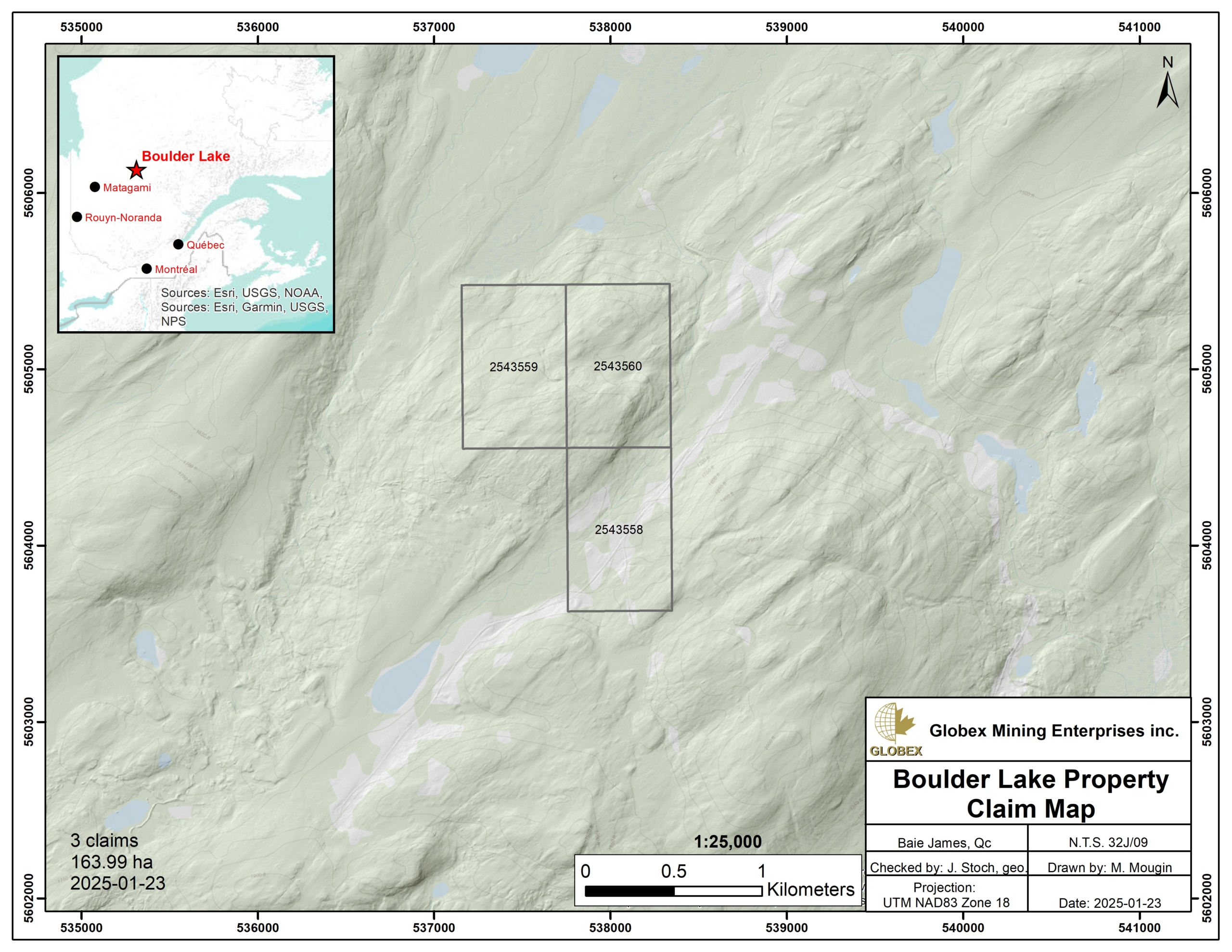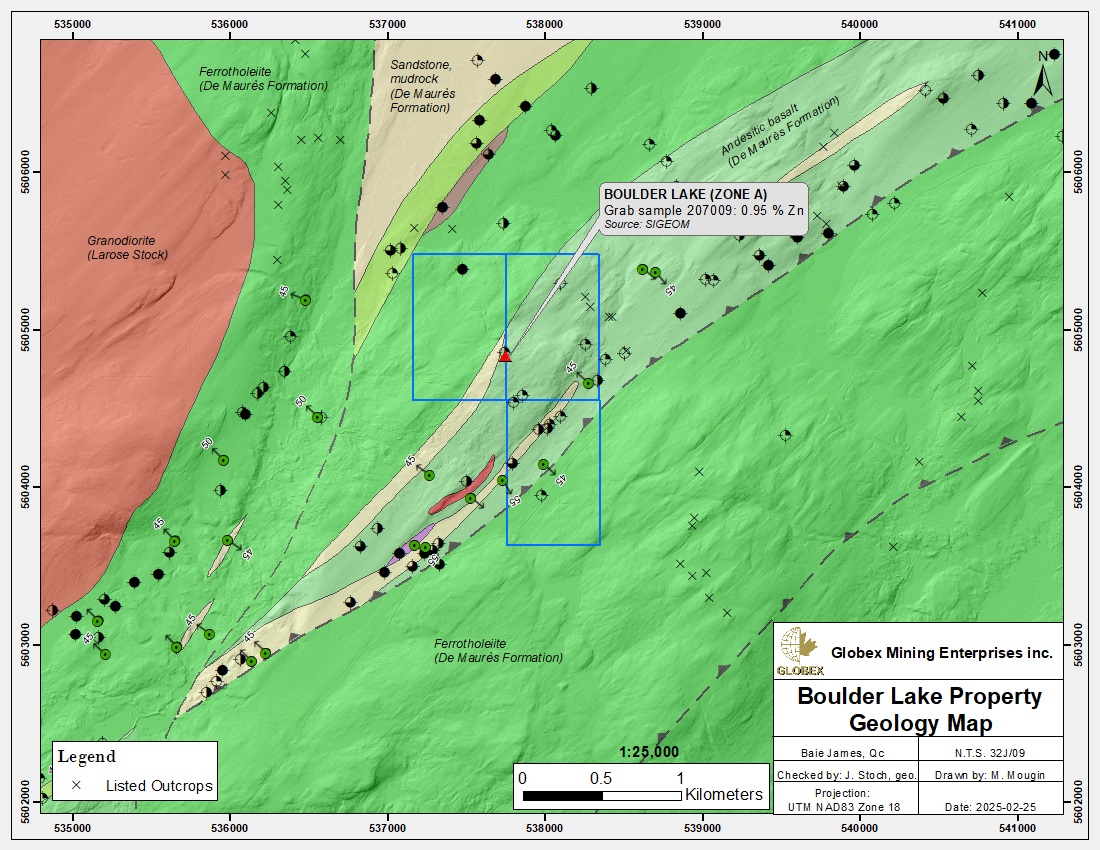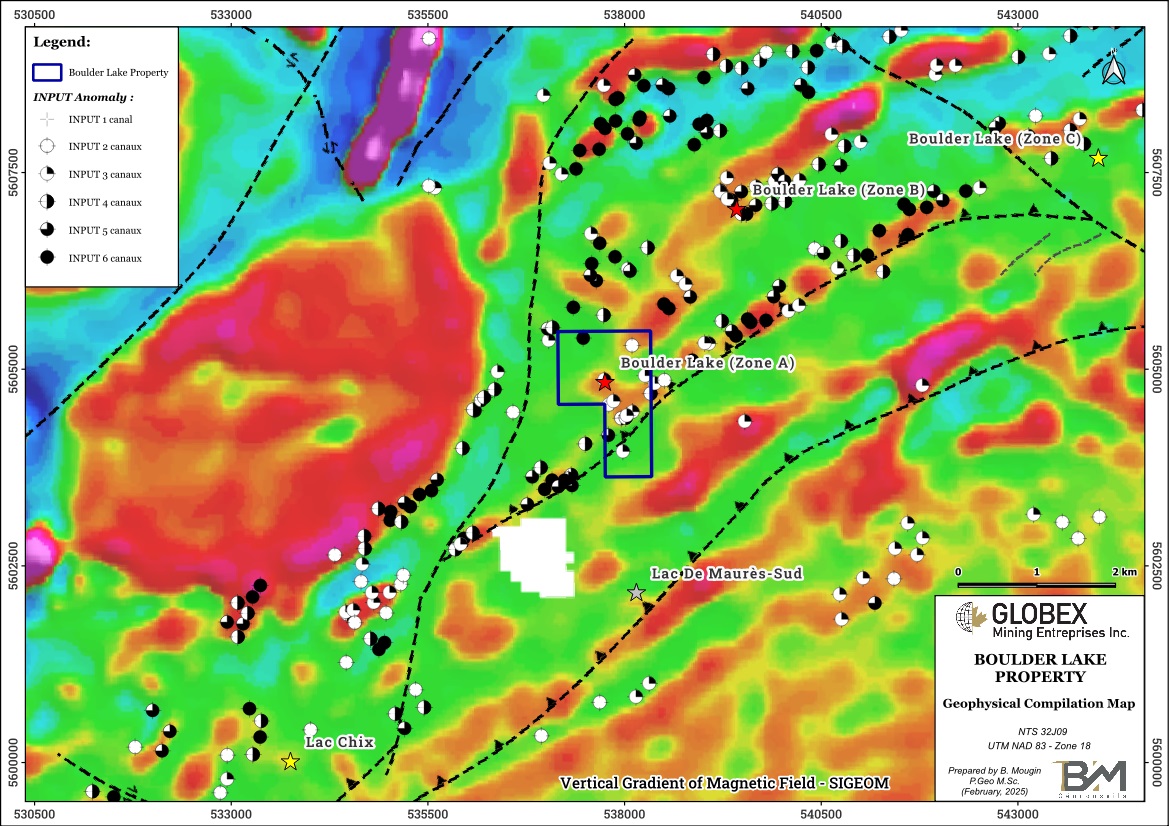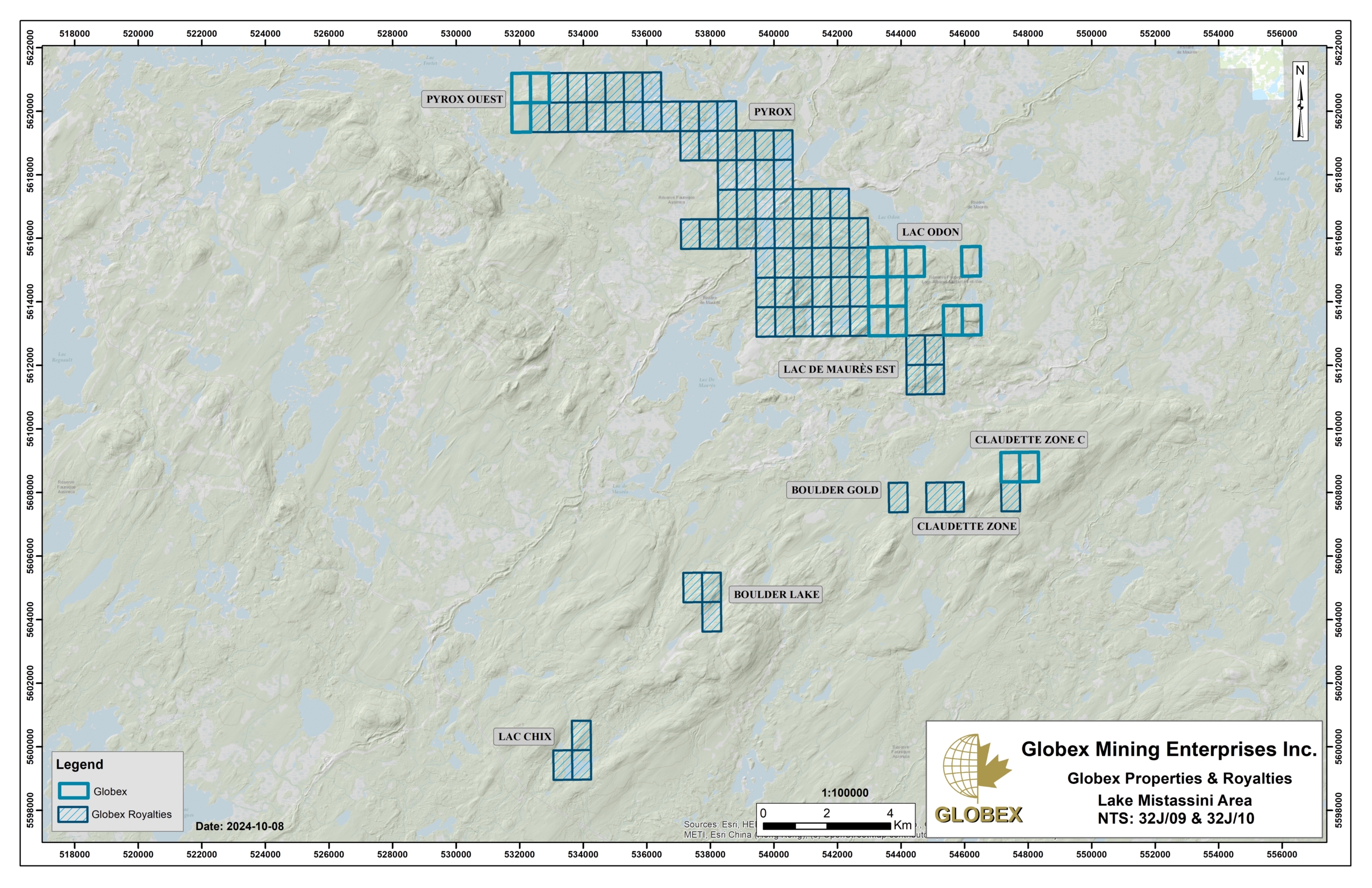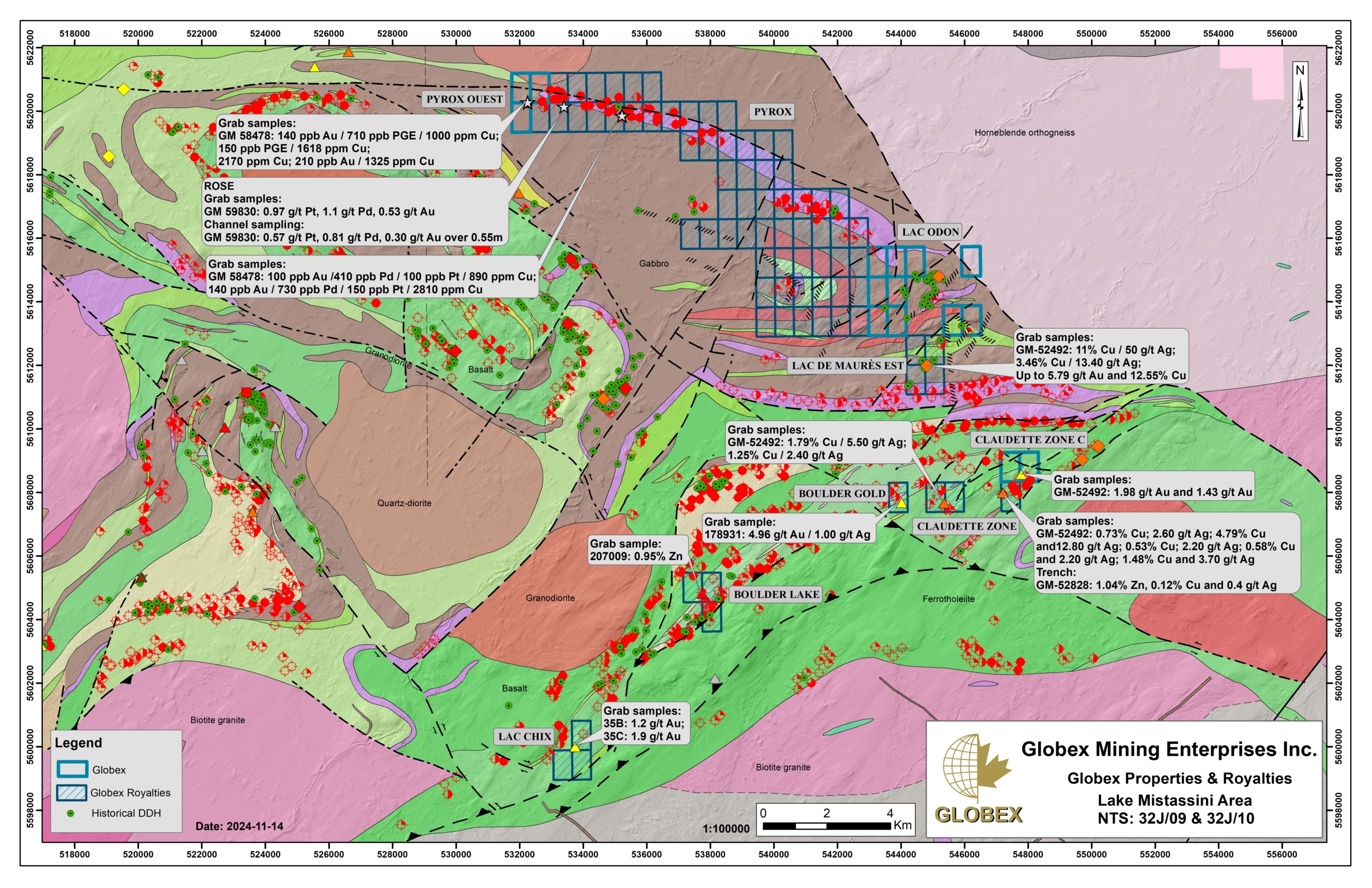Boulder Lake
Location, Access, Description
The Boulder Lake property is located about 75 km north of the town of Chibougamau, in the Nord-du-Quebec administrative region. The property is composed of three (3) mining claims covering 163.93 Ha in NTS 32J09, Eeyou-Istchee James Bay Territory. Titles are owned by a company registered under the name 9474-9454 Québec inc. and Globex retains a 2% Gross Metal Royalty (GMR) on it. The property is set on Category III lands where exploration is allowed under authorization of Native Communities.
The property is accessible by road from Chibougamau, driving about 20 km on Road 167 north then turn left on Route du Nord for about 80 km. Then a network of gravel roads leads to the property about 12 km further to the east.
Many commodities can be found in Chibougamau regarding contractors, equipment rental, as well as sleep and food accommodation of remote workers. A hydro power line strikes approximately N-S toward Chibougamau, about 4 km east of the property.
Geology and Mineralization
The Boulder Lake property is located in the Opatica Sub-province of the Superior Province of the Canadian Shield (Card and Ciesielski, 1986). Rocks of the Opatica deposited between 2.82 and 2.68 Ga (Davis et al., 1995) and consist of both volcano-sedimentary rocks and gneissic domains (Hocq, 1994). Metamorphism gradually increases from south to north from the greenschists grade to the granulites grade, with evidences of partial melting (Sawyer and Benn, 1992). New geological and geochronological data indicate that the Abitibi and Opatica sub-provinces form a single lithotectonic block where Opatica represents the basal part of the Abitibi crust (MB2014-04, MB2016-01).
Rocks of the area of the Boulder Lake property belong to the Archean Frotet-Evans Volcanic Belt (FEVB), a 250 km long structure which represents the second most important belt in Quebec and hosts the former Au-Cu Troilus Mine located about 45 km north of the property (Production 1997 – 2009 : 67.95 Kt @ 0.1% Cu and 1.07 g/t Au ; DV2010-01). The FEVB is a E-W to ENE-oriented Archean volcano-sedimentary band steeply dipping toward north, hosted in gneiss-plutonic terranes.
The FEVB is generally divided in four (4) different segments : Evans-Ouagama; Storm-Evans; Assinica and Frotet-Troilus (Boily and Dion, 2002) ; the Boulder Lake property is located within the Frotet-Troilus one. Rocks of the Frotet Formation mainly consist in calco-alkaline pyroclastic deposits with intercalated gabbro and UM sills deposited between 2,793 and 2,755 Ma (Pilote et al., 1997, MB2000-12).
Numerous Gabbro sills are intercalated within the volcanic rocks of the FEVB and seem comagmatic with the volcanics. Historical geophysical surveys highlighted strong magnetic axis corresponding to peridotite and pyroxenite sills, as well as EM conductors. Granophyre sills are frequently observed in intercalation within the volcanics and are interpreted as the end product of fractional crystallization of the parent mafic magma.
Polyphase deformation of the area occurred between 2.7 and 2.65 Ga and varies from weak in the central part of the FEVB to intense on the south and north edges. The major structural features of the area are the Nottaway River and the Lucky Strike Stream shear zones and the Frotet anticline.
Granitoids intruded the area after major deformation phases (ET84-08). Metamorphism of the FEVB is at the upper greenschists grade to lower amphibolitic grade (RG96-11).
The property is located in the south structural domain of Gosselin (ET96-02). Regional foliation is NE-oriented. Several NE-SW fold axis are recognized in the property area and are concordant to the regional foliation. Both NE and ESE faults are also recognized in the vicinity of the property.
On the Boulder Lake property, the Frotet-Troilus segment is mostly represented by intermediate and mafic volcanics of the De Maurès Formation. Volcanic rocks of the De Maurès Formation generally show pillowed textures, sometimes porphyritic. Affinity is tholeiitic to calk-alkaline from base to top of the rock sequence (ET96-02). Some pyroclastic and sedimentary horizons are locally intercalated within the volcanics, as well as quartz-feldspar porphyry (QFP) dykes.
Since the 1950s, numerous mineralized showings have been discovered in the Frotet-Troilus region. These are grouped into three main categories: 1) Au-Cu, Cu-Au-Ag vein-type mineralization ; 2) Sulphide associated gold mineralization (Py-Po-Cp) and 3) Zn-Cu-Ag-Au volcanogenic mineralization.
The Boulder Lake (Zone A) Zn showing has been recognized on the Boulder Lake property. Traces to 3% pyrite (chalcopyrite pyrrhotite) are disseminated in a mafic chloritized and hematized lapilli tuf in contact with massive to pillowed amphibolitized basalts of the De Maurès Formation. A grab sample taken by Inco Exploration in prospection in 1992 returned 0,95% Zn (GM52209).
The Claudette Zone A to E Cu-Ag-Au showings and deposits extend from 7 to 12 km ENE of the Boulder Lake property. Mineralization is composed of various quantities of pyrite, pyrrhotite and chalcopyrite in quartz veins cutting graphitic sediments within the volcanics (GM52492). On the Vertical Gradient of Magnetic Field, these showings appear to be associated with a ENE-oriented high magnetic anomaly, defining thus a mineralized structure more than 5 km long.
The Lac Odon Cu-Mo deposit is located within the De Maurès syncline hinge, about 12 km north-east of the Boulder Lake property. Mineralization is both massive and within quartz veins ; it is hosted in a N220°/-25° shear zone injected with felsic material, inside a sericite-altered gabbro. Historical Resource (non NI 43-101 conformable) is estimated to 8,000t @ 3.01% Cu and 0.10% Mo (GM28490, ET96-02).
Platinum Group Element mineralization (PGE) is also present in association with UM intrusive rocks in the area of the Boulder Lake property. Trenching by Virginia Mines west of the property in 2001 exposed a massive and homogeneous gabbro containing up to 1% finely disseminated pyrrhotite and chalcopyrite (GM59830). Historical work highlighted the Pyrox II East (0.15 ppm Pt, 0.73 ppm Pd, 0.14 g/t Au, 0.28 % Cu and 0.07% Ni), Pyrox II West (0.3 g/t Au, 0.57 g/t Pt and 0.81 g/t Pd over 0.55 m) (GM58478) and Rose (0.97 g/t Pt, 1.1 g/t Pd and 0.53 g/t Au) showings, located about 15 km NW of the property (GM59830).
The former Troïlus mine, located about 45 km north of the property, produced 2 million ounces of gold and nearly 70,000 tonnes of copper between 1997 and 2010.
Spodumene pegmatites are also listed at Moblan, about 35 km WNW of the Boulder Lake property, within the Frotet-Evans volcanics. Mineralized dykes are grouped in the hinge of the Frotet anticline (Pearse, 2008). In date of January, 2024, Probable Reserve at Moblan are estimated to 34.54Mt @ 0.63% Li (NI 43-101 Feasibility Study Report for the Moblan Lithium Project, Eeyou Istchee James Bay Territory, Quebec, Canada).
History
Exploration in the property area began in the late 1950s and mainly consisted in geophysical and prospecting work.
Trenching and diamond drilling by Tache Lake Mines in 1963 (GM13723) led to the discovery of the Lac De Maurès-Est showing (1.60% Cu over 2.8 ft – DDH B2) about 9 km NE of the property. The company drilled 5 holes (1,521 ft) in 1963, then executed 6 more DDH (1,150 ft) in 1966 (GM18180). No economic mineralization has been encountered and the company dropped the claims (GM18254).
Canadian Nickel Co. Ltd and Conwest Expl Co. Ltd. undertook some exploration in the vicinity of the Boulder Lake property during early 1960’s and drilled a couple DDH to test some Mag and Input anomalies (GM13736, GM16947). Weak Ag and base metals anomalies were observed.
The Lac Odon showing was discovered in 1971 by prospection and trenching by Cerro Mining (GM27663). Numerous exploration work have then been carried-out by successive companies in the surroundings of the Lac Odon showing. Works included geophysics Mag, EM and IP surveys (GM31741, GM44954, GM46960, GM53518), lake sediments geochemistry (GM34169, GM34187), trenching (GM54407) and diamond drilling (GM28490, GM55787, GM62463). Historical exploration succeeded in defining a ENE to NE-oriented mineralized structure over more than 400 meters within sheared gabbro and peridotite. Historical resource of 8,000t @ 3.01% Cu and 0.10% Mo have been estimated on the Lac Odon deposit (ET96-02).
In early 90s, following the discovery of an angular Cu-Zn-bearing massive sulfide boulder in the Lac De Maurès area, Inco Exploration undertook airborne and ground electromagnetic and magnetic surveys, geological mapping, prospecting, trenching and diamond drilling on the Boulder Lake and Claudette properties (GM52209, GM52828 and GM52492). These works led to the discoveries of the Boulder Lake and Claudette Zone showings. Inco drilled 2 DDH on the Boulder Lake property in 1993 to test HELM conductors (GM52210). The program failed to identify any significant VMS style mineralization or alteration.
In 2022, Troilus Gold Corp. conducted an extensive exploration program within the Frotet-Evans segment of the FEVB (GM73251). The Boulder property area has been investigated by this work but no grab sample was taken there.
Resources and Potential
The Boulder Lake property benefits of a favorable geologic context which is attested by the presence of numerous Cu (±Ag), Au and Zn showings and deposits in the surroundings.
Mineralization of the area appears to be strongly associated with ENE to NE positive magnetic anomalies concordant with the regional foliation and associated with moderate to strong input anomalies, which makes it easy to identify on geophysical surveys. Such coincident magnetic features are present along a thrust fault in the southern part of the Boulder Lake property, fully justifying the continuation of exploration work with ground geophysics.
Future exploration work should include both ground Mag and IP surveys in order to highlight priority targets. This work should primarily be carried out along the magnetic axis associated with input anomalies, following a regional thrust fault in the southern part of the property. Depending of the results, mechanical stripping and channel-sampling would be necessary.
Globex also holds numerous strategic claims and royalties in the vicinity of the Boulder Lake property (maps below).

